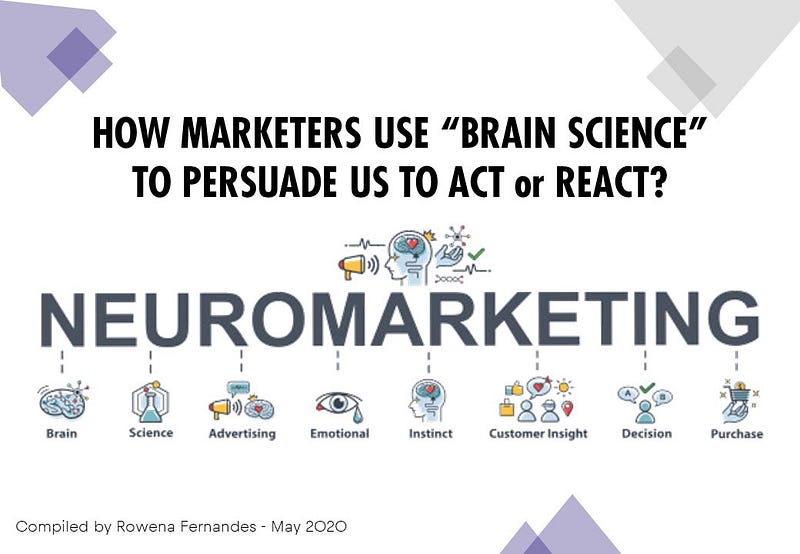

How Marketers use “Brain Science” to persuade us to act or react
Can marketers induce a sale?
By Rowena Fernandes, ‘Challenging Stereotypes.’

Even wondered why do we do the things that we do? What is brain science or Neuroscience?
In simple words is the understanding of the structure, working and development of the nervous system (which transmits signals between different parts of the body) and the brain. In short, how our brain and body interact with each other. As consumers, we ought to pay attention to neuroscience because we’re reacting it all the time without even realizing it. For example, when did you last purchase something as there were only 2 items left in stock? This is called the law of artificial scarcity; the value of a product increase when it is scarce and decreases when in abundance.
Remember once we understand how our brains work, we can make better decisions. In fact most of the decisions we make aren’t based on fact; rather, they’re based on what we subconsciously believe about something. We react versus respond. Now that we are aware of the importance of Neuroscience in our life; let’s proceed to understand what causes us to react or take an action.
Most of you will agree; when I say, “advertising materials causes us to react rather than respond”. After all “Brands are nothing but a bundle of emotions”. In fact marketers use persuasion rather than push strategy to cause us to react or take an action. There are two different types of persuasion: rational and emotional. Rational persuasion are promotions, offers, incentives that promotes sales. But it is emotional persuasion that creates relationships and builds strong, successful brands.
Let me explain Emotional persuasion with an example. If you think about when you meet someone, you’ll realize that you might be influenced to meet them again by not what they say, but you are influenced to become friendly towards them by the way they say things. Extending this analogy to marketing, brands can promote sales using the content of their advertising — by demonstrating added value, cutting price, improving performance, and so on. But brands build enduring relationships through ‘relationship-building’ meta-communication in their advertising. For example, Colgate didn’t become a super-brand just by preventing tooth decay like every other toothpaste.
Mentioned below are 3 methods that are mostly used to persuade us emotionally to take an action or react in a particular way.
The first method is “to create a sense of tribe” — man is a social animal and the need to belong is the most primitive and latent need of any human being. Most marketer create marketing communications that makes target audience feel like they’re a part of the organization or a tribe. The English Premium League football clubs execute this brilliantly — every time the club loses a team; the fan states that “we lost” and not “the club lost”. This is the power of internalizing the content such that the line between the club and the fan are not treated/viewed as a separate entity but as one being.
Mirroring is yet another technique used to promote a positive action or reaction to marketing communication. Mirroring is a behaviour in which we subconsciously imitate (or mirror) the gestures, speech patterns, and attitudes of another “safe” person or authority. Your subconscious brain says, “Yes, this is the right behaviour because this is what your favourite celebrity or influencer or friends are doing in the tribe.”
And the fascinating thing is when you mirror someone, dopamine is released. Dopamine is a reward hormone that makes you feel good. A classic example is Beard (facial hair) fad which many men across globe have embraced in the last few years.
The 3rd technique is called endowment. Endowment is the idea that we are attached to things that we already do or have or own. We tend to be emotionally attached to things and are unwilling to let them go. What this means is that we tend to value things in which we put in our efforts much more than what it is worth. Most CPG commercials reflect this. For example, instant noodles — each ad shows that the target consumer is taking the effort to cook this dish and hence increases the affiliation to the brand.
To summarise; human brain is most fascinating thing ever and the more we learn about it the less we know. Hence its best that we are aware of how our brains works and the next time you want to act or react to particular commercial or advert you might as well do it for the right reasons.
Author
Rowena Fernandes
Editor
Mridula Saravanan
We at CaratLane are solving some of the most intriguing challenges to make our mark in the relatively uncharted omnichannel jewellery industry. If you are interested in tackling such obstacles, feel free to drop your updated resume/CV to careers@caratlane.com!

Leave a Reply